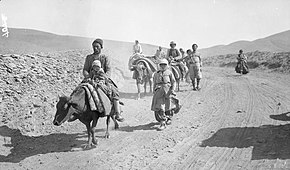
Back Völkermord an den Aramäern ALS مذابح سيفو Arabic ܩܛܠܥܡܐ ܣܘܪܝܝܐ ARC مذابح سيفو ARZ Aysor soyqırımı Azerbaijani Генацыд асірыйцаў Byelorussian Асирийски геноцид Bulgarian আসিরীয় গণহত্যা Bengali/Bangla Gouennlazh an Asirianed Breton Genocidi assiri Catalan

The Sayfo (Syriac: ܣܲܝܦܵܐ, lit. 'sword'), also known as the Seyfo or the Assyrian genocide, was the mass murder and deportation of Assyrian/Syriac Christians in southeastern Anatolia and Persia's Azerbaijan province by Ottoman forces and some Kurdish tribes during World War I.
The Assyrians were divided into mutually antagonistic churches, including the Syriac Orthodox Church, the Assyrian Church of the East, and the Chaldean Catholic Church. Before World War I, they largely lived in mountainous and remote areas of the Ottoman Empire and Persia, some of which were effectively stateless. The Ottoman Empire's nineteenth-century centralization efforts led to increased violence and danger for the Assyrians.
Mass killing of Assyrian civilians began during the Ottoman occupation of Azerbaijan from January to May 1915, during which massacres were committed by Ottoman forces and pro-Ottoman Kurds. In Bitlis province, Ottoman troops returning from Persia joined local Kurdish tribes to massacre the local Christian population (Armenians and Assyrians). Ottoman forces and Kurds attacked the Assyrian tribes of Hakkari in mid-1915, driving them out by September despite the tribes mounting a coordinated military defense. Governor Mehmed Reshid initiated a genocide of all of the Christian communities in Diyarbekir province, including Syriac Christians, facing only sporadic armed resistance in some parts of Tur Abdin. Ottoman Assyrians living farther south, in present-day Iraq and Syria, were not targeted in the genocide.
The Sayfo occurred concurrently with and was closely related to the Armenian genocide, although the Sayfo is considered to have been less systematic. Local actors played a larger role than the Ottoman government, but the latter also ordered attacks on certain Assyrians. Motives for killing included a perceived lack of loyalty among some Assyrian communities to the Ottoman Empire and the desire to appropriate their land. At the 1919 Paris Peace Conference, the Assyro-Chaldean delegation said that its losses were 250,000, about half the prewar population. The accuracy of this figure is unknown. They later revised their estimate to 275,000 dead at the Lausanne Conference in 1923. The Sayfo is less studied than the Armenian genocide. Efforts to have it recognized as a genocide began during the 1990s, spearheaded by the Assyrian diaspora. Although several countries acknowledge that Assyrians in the Ottoman Empire were victims of a genocide, this assertion is rejected by the Turkish government.